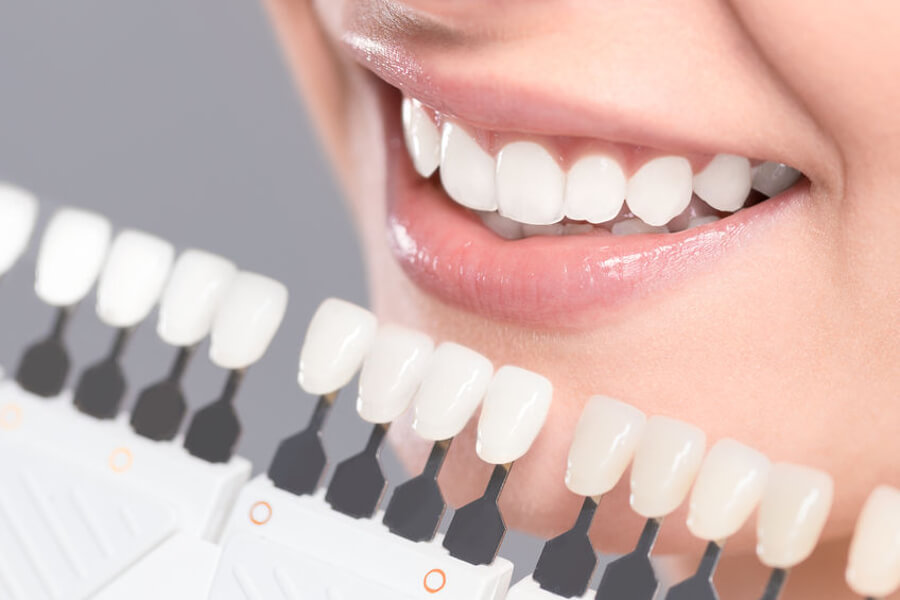Teeth whitening (Bleaching)
Bleaching is a commonly used procedure in dental esthetics. We use this method to enhance our patient’s smile through brightening their teeth, so this method is usually recommended to persons who have discolored teeth.
What are the main causes for teeth discoloration?
- Smoking is one of the main causes for having an undesirable smile.
- High consumption of caffeine, colored foods or drinks (tea, red wine, berries, cola etc.) contributes to teeth discoloration over time.
- Aging. It is natural for teeth to darken as we age.
- Trauma. An injury to the tooth might cause a color change.
- Tooth color sometimes runs in the family, so a genetic component can be the reason for having yellow or dark colored teeth.
- Medicine, like some antibiotics (e.g., tetracycline and doxycycline administered in childhood).
- Illnesses, like some metabolic diseases (e.g., calcium deficiency) and eating disorders.
- Developmental anomalies of tooth enamel (can be caused by higher levels of fluoride during the teeth mineralization process).
- Poor dental hygiene. Without a proper oral hygiene routine (brushing and flossing at least twice a day) and regular professional teeth cleaning in the dental office, teeth will become stained over time.
- Without a proper oral hygiene routine (brushing and flossing at least twice a day) and regular professional teeth cleaning in the dental office, teeth will become stained over time.
What methods can we use to whiten teeth?
- Whitening toothpaste: using a toothpaste designed to brighten your teeth will keep their natural whiteness and a healthy aspect of your smile. They might whiten one or two shades over time.
- Whitening strips: the strips have to be in contact to the enamel for about 30 minutes a day. This method will also whiten your teeth gradually.
- Bleaching at home: whitening your teeth at home is a method that allows the color to change over a longer period of time (one or two weeks) and because of this, it is considered as one of the less aggressive approaches. A whitening gel is placed into special trays (manufactured in the Dental Laboratory) that need to be kept inside the mouth for several hours. This might be done either during the day or the night. The risk of misuse or overuse is always an important aspect to consider when choosing this method, because it can lead to gum irritation and hypersensitivity.
- Bleaching in the Dental Office: this is most effective solution for whitening your teeth. Our dental hygienist will brighten your teeth in one session, using a whitening gel and a special LED / Laser light. It is usually done in an hour or less. This method, however, is not for everyone! For more information about the procedure and its indications, contact our Dental Office.
Important aspects you need to consider before bleaching:
It is best to consult your dentist before trying anything by yourself. All methods will determine a certain degree of tooth sensitivity and bleaching is not recommended to all patients. You may need to have other repairs (like caries or gingival recession) done and usually a professional teeth cleaning is indicated before whitening. Schedule an appointment for discussing your options first. Especially if you already have sensitive teeth!
If you are planning to get: fillings, crowns, bridges, Veneers, Lumineers or any other dental prosthetic work, keep in mind that these are materials that do not change color through bleaching. So, you need to have your teeth whitened prior to any tooth (or tooth structure) replacement procedure, in order for our dentists and / or dental technicians to be able to match the desired shade.
How does it work?
Any smile enhancement procedure will begin with the first clinical examination. Our doctors will assess the general state of your oral health, the level of commitment to dental hygiene and will take note of any problems that you might have with your teeth, your gums and your bite. After considering our findings, we will discuss your options together.
Most likely we will recommend a professional teeth cleaning before going any further, because we need to remove any stains that cover the enamel for the whitening gel to be effective. Once all other issues are resolved (tooth decay, gum recession etc.) and your teeth and gums are healthy, we may proceed to the whitening method best suited for you.

If Bleaching in the Dental Office is chosen, then here’s what you need to know about how it works:
- Our dental hygienist will place a lip retractor to protect them from contact with the whitening gel.
- Once you are comfortable, a special gel will be applied to cover the gingiva.
- The whitening gel is then applied to the tooth enamel.
- The whitening lamp is adjusted into place and turned on.
- The procedure is divided into 15 minutes-intervals, so after each interval the gel is removed and the color is assessed. We will decide how many intervals are needed depending on the color we wish to achieve, but the maximum number of intervals in one session is 4 (one hour in total).
- The gel is completely removed from your teeth and washed off; the gingival protection is removed as well.
- An after-whitening-mousse is applied on your teeth.
- Our dental hygienist will give you all the necessary instructions for the following days and for keeping your smile bright for as long as possible.
Are there any side effects for whitening?
After bleaching you can expect some tooth sensitivity, especially to extreme temperatures (hot and cold) for a few days. Some irritation to the gums may also occur. The side effects will pass in a short while if you properly care for your teeth and follow your dentist’s instructions throughout the healing process. When using at-home products, carefully read the instructions and ask your dentist about the methods you want to try. If you get sores or you experience severe pain, discontinue the use of all products and ask us to guide you further! Too much whitening is a great risk when trying to bleach your teeth on your own. All whitening products have a recommended time period, so be careful not to use them for any longer than that, because it may cause irreversible damage.

After Bleaching in the Dental Office:
Your new enhanced smile needs to be cared for in order for, in order to last for as long as possible. After the procedure, you should avoid tobacco, colored foods and drinks for several days, because the enamel will stain more easily. In any case, tooth color will return to its usual shade over time, so keeping a good oral hygiene routine will help with maintaining the brightness for longer. We might give you a special tooth paste that you need to use in the following days. This helps the remineralization process and prolongs the whitening effect.
The best way to enhance your smile is always with the help of your doctor! Schedule an appointment in our clinic and mention that you wish to talk about Bleaching or teeth whitening!
If you need an appointment please contact us.
DIAGNOSIS
PROPHILAXYS
DENTAL ESTHETICS
DENTAL PROSTHETICS
DENTAL SURGERY
PERIODONTOLOGY
For any questions or making an appointment, please get in touch
Get to know us

Dr. Molnár Lehel Ferenc
Dentist & specialist in oral surgery

Dr. Alexandra Cristina Rus
Dentist

Dr. Molnár Szabolcs Mihály
Dentist

Dr. Huber Gergely
Orthodontist
Contact
If you have any questions or would like to make an appointment, do not hesitate to contact us!
Molnar Dental
Várkerület 43
H-9400 Sopron
Ungaria
Telefon
+43 (676) 699 77 35
+36 (30) 146 9080
info@molnardental.com
OPENING HOURS
| Mo: | 8:30-18:30 |
| Tu: | 8:30-18:30 |
| We: | 8:30-18:30 |
| Th: | 8:30-18:30 |
| Fr: | 8:30-18:30 |
| Sa: | 8:30-18:30 |
| Su: | closed |
Visit by prior appointment.
CONTACT
Address: Várkerület 43
9400 Sopron, Hungary
+43 (676) 699 77 35
+36 (30) 146 9080

